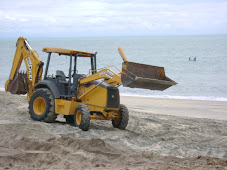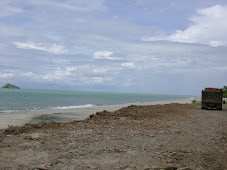Some Panama squatters losing homes
Developers are pushing long-established coastal squatters from their picturesque homes.
Posted on Mon, Oct. 15, 2007
BY BENJAMIN SHORS
Special to The Miami Herald
HOLLY PICKETT/FOR THE MIAMI HERALD
Rosendo Garcia Molina, right, stands in the ruins of his former home, which was destroyed in a fire in Bocas del Toro, Panama. Molina, who was in a land dispute over potential development, believes the fire was set intentionally.
ISLA CARENERO, PANAMA --
In the late 1980s, Nicasio Jiménez built two listing shacks with mangrove beams, a roof of scavenged tin, and rough floor planks that allowed Caribbean breezes and biting flies to flit through the cracks.
Jiménez, a 61-year-old retired banana pruner who earned $1 an hour, did not own the waterfront land. Like hundreds of other low-income people living in Bocas del Toro, a stunning archipelago once relegated to some of Panama's poorest residents, he instead relied on ''squatter rights'' written into the country's law.
Now, as foreign investment transforms these languid islands, Jiménez' family faces eviction from a Naples developer who claims he bought the property from a third party.
''Before, nobody wanted this land,'' said Feliciano Santos, Jiménez's 36-year-old son-in-law. ``You didn't need documents. This was a garbage disposal area. We are the ones who cut our feet and got dirty working the land.''
For centuries, this Caribbean island has been a beautiful place to be dirt poor. But in recent years, a booming real estate market has brought American entrepreneurs into direct conflict with Afro-Caribbean and indigenous Indians who occupy these once-isolated isles.
Now, developers have targeted an emerging demographic: retirees from America and Europe.
Although American expatriates have been a part of the funky vibe in Bocas since the 1990s, they remained a relatively minor note in the Caribbean town. But as development in Panama City boomed -- construction permits last year topped $1 billion -- investors pushed into more remote reaches of the country.
Now, critics say, the size of the new developments threaten to displace hundreds of low-income island residents, many of whom live on prime oceanfront real estate.
In the past year, the conflict has spiraled. Armed private security guards patrol disputed beaches. A powerful union of construction workers has leveled charges of ''colonialism'' against several developers. Homes have mysteriously burned and been torn to the ground.
''There is this tremendous lust for the coastline,'' said Osvaldo Jordan, executive director of the Alliance for Conservation and Development, a Panamanian nonprofit based in Panama City. ``Developers and speculators will use any means necessary to get the land from the people.''
THE ISLAND LAW
In an attempt to restore order last year, President Martín Torrijos signed the Island Law, which provides incentives for investors to develop large residential communities for foreigners, while also attempting to preserve the rights of locals who have lived and farmed the land for decades.
Specifically, the law sought to attract developments with home prices above $300,000 -- a fortune in a country with a median income of $5,000.
On the day of the law's signing, developers unveiled plans for more than $700 million in new projects in Bocas del Toro -- evidence, critics say, that the law will only further disenfranchise the island's poor.
'The government has said, `Let's open ourselves to the highest bidders,' '' said Linda Barrera, a former law clerk with the International Environmental Law Project at Lewis and Clark Law School in Portland, Ore., and a Panamanian citizen. ``A small indigenous family may not have the resources that the developers have to establish the title. It's an expensive process.''
As Panamanian officials attempt to sift through the competing land claims, activists for the poor have criticized the government's lack of transparency, and local offices have been plagued with accusations of bribery.
The land dispute has spilled into the American legal system, where the owners of the Red Frog Beach project sued two Texas men and a Delaware corporation in a dispute over a 25-acre beach. Both groups have plans to develop the beach, which serves as a critical nesting area for several species of sea turtles.
LEGAL BATTLE
Attorneys for Red Frog -- a $400 million development with plans for 900 condos and villas, two marinas, a hotel and spa -- allege that a competing group, Cinco Cruces de Oro Holdings, bribed the local sheriff, which led to the jailing of a dozen Red Frog employees. Cinco Cruces denied any wrongdoing.
''Very strange and awful things have been happening here,'' said Michelle Slough, marketing director for Red Frog in Bocas. ``But little by little, we are trying to solve the land disputes and educate the community.''
As the case makes its way through the Texas legal system, a tense situation continues on the beach. On a hot afternoon this summer, security guards for both companies rested in the shade along the sandy shore, their camps located about 200 yards apart. Some carried automatic weapons. Others slept with shotguns at their sides.
''At first, we were very enthusiastic about these projects,'' said Rutilio Milton, 50, director of a small Ngobe Indian crafts cooperative along a bay where Red Frog plans to build a 250-boat marina. ``We thought the whole community would be part of this planning. But now this is so big we are afraid we will disappear.''
Some foreigners say they are only now realizing the difficulties of living in a town that, prior to the year 2000, did not have a paved road connecting it to the rest of Panama. On the islands, air travel, healthcare and even clean drinking water can be inconsistent.
EASILY DECEIVED
''It's not too hard to blind people to how weak their investment is,'' said a British citizen who moved to the islands four years ago but asked not to be identified because she runs a small business. ``If you scratch beneath the surface, you can see the fault lines.''
Those lines are striking on Isla Carenero, where Jiménez built his tiny home with no running water or electricity.
One hundred yards down the beach, 57-year-old J. Stephen Crabtree, formerly of Naples, built three small casitas for tourists, and lined the paths of his Careening Cay Resort with native flowers. His wife, Joan, opened the Cosmic Crab Café, which sits on stilts above the waters of the Caribbean.
''I've put my life savings into making this the most beautiful place in Bocas,'' Crabtree said. ``This is ideally what the Panamanian government wants to see -- an entrepreneur bringing in money and hiring locals at a living wage.''
Crabtree said he paid more than $150,000 to buy the land from an Afro-Caribbean woman whose father once harvested mangrove trees on the property.
Jiménez and his family said they have never received any documents showing that Crabtree owns the land. Crabtree said his attorney continues to work through the legal process, even as the situation between the neighbors worsens.
PUBLIC HUMILIATION
''They have slandered me on television,'' said Crabtree, who also works as a real-estate agent in the islands. ``They put you in jail for that here.''
Panama, he insisted, should ''serve as a model for Central America'' for its efforts to protect the rights of property owners.
''If you have the documents in place, the courts are fair,'' Crabtree said, sitting with visitors on his dock above the Caribbean waters. ``The next move -- once we oust these people -- will be to clean up the bay where they have been going to the bathroom for 12 years. When I get done, the place next door is going to look just like this.''



